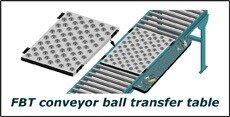[Seconding what [USER]Van[/USER] said in post#16 above...]
The only way a ball transfer
(Notice McMaster doesn't call them casters? They're intended to be mounted ball up, fairly close together on assembly lines/freight handling: )
)
with a diameter of 11/16" could ever work is if you had a stage deck of seamless 1/4" steel plate (and even then it's dubious).
Try this when they come in:
"Caster" up one of your stock 4x8 platforms, one caster in each corner and one in the center of each long side. Flip it over and load 200 pounds of pig weight on it. Watch the six gouges on your nice tempered hardboard stage as you attempt to drag, not roll, the "wagon" around.
There's just no substitute for high-quality casters, talking minimum $25-30 each. Since they're 100% re-usable, it's a lifelong investment with proper periodic maintenance.
From the thread http://www.controlbooth.com/forums/scenery-props-rigging/16227-caster-psa.html :
The only way a ball transfer
(Notice McMaster doesn't call them casters? They're intended to be mounted ball up, fairly close together on assembly lines/freight handling:
 )
) with a diameter of 11/16" could ever work is if you had a stage deck of seamless 1/4" steel plate (and even then it's dubious).
Try this when they come in:
"Caster" up one of your stock 4x8 platforms, one caster in each corner and one in the center of each long side. Flip it over and load 200 pounds of pig weight on it. Watch the six gouges on your nice tempered hardboard stage as you attempt to drag, not roll, the "wagon" around.
There's just no substitute for high-quality casters, talking minimum $25-30 each. Since they're 100% re-usable, it's a lifelong investment with proper periodic maintenance.
From the thread http://www.controlbooth.com/forums/scenery-props-rigging/16227-caster-psa.html :
I just remember what my Old Uncle Footer used to tell me;
"Son, Life's too short for cheap casters."
Then he'd spit, turn, and waddle off, Festus-like into the sunset. ...
Last edited:


